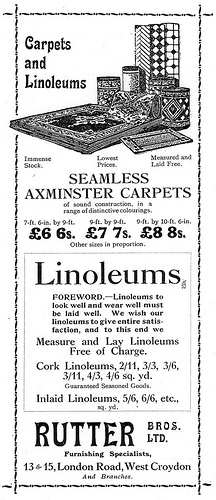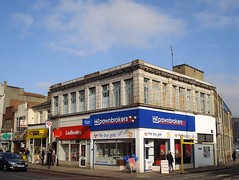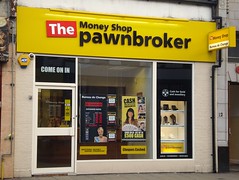While H & T Pawnbrokers at number 12 is a fairly new addition to London Road, Cash Converters at numbers 13–15 has a somewhat longer tenure in the area.
1863: Construction of the building
13–15 London Road was built in 1863,[1] as part of a block with numbers 17, 19, and probably 21.[2] At this point, the lots on either side of this block hadn’t yet been built on, and the nearest neighbours fronting on London Road would have been at numbers 5 and 31.[3] Number 5 was an auctioneer — either Edward William Cannon or John Manley — and number 31 was the private residence of James Janes, commercial traveller.[4] Between 21 and 31 were the grounds of the Congregational Chapel, which itself was set back around 30 metres from the road.[6]
1860s–1890s: Benjamin Culpeck, coachbuilder
The first occupant of 13–15 London Road was Benjamin Culpeck, coach builder and harness maker.[7] It’s possible, in fact, that the building was constructed to his specifications. As shown on the 1868 Town Plans above, it seems to have been planned as a double-fronted property from the start, and there was a built-in alleyway (still present today) between 13–15 and 17, leading to a large yard with a couple of outbuildings — ideal for building and repairing coaches.
Benjamin Culpeck was born in 1830, and moved to Croydon from his native Suffolk by 1853.[8] Initially setting up his coach building business at 54 North End, he moved shortly after to 65 North End and by 1865 was installed in his new London Road premises. He retained his North End premises in parallel for a few years, but had given them up by 1872.[9]
Culpeck’s carriages were in demand not only in Croydon, but as far afield as Australia. An advertisement in the 14 April 1860 edition of Empire, a Sydney newspaper, states that “BURT and CO. have just received, ex Ellwood Walter, some very choice BASKET PHAETONS, WAGGONETTES, and other vehicles, by Culpeck Croyden [sic], Atkinson and Philipson, Newcastle-on-Tyne; Windover and Wilson, Northampton; and other noted builders.”[10]
Culpeck’s coach yard remained at London Road for another four decades. Benjamin Culpeck himself appears to have taken a back seat as he got older; from 1897 onwards, Ward’s street directories list a resident manager — Harry Marchant — at the premises.
1900s: William H Hamshaw, coachbuilder
Mr Culpeck also appears to have become quite a substantial citizen of the town. Street directories from 1889 onwards list him under “Principal Residents” at Southwold, 42 Kidderminster Road,[11] and Ward’s 1904 directory includes his death in April 1903 in its list of the preceding year’s important “chronological events”. Following his death, his business was taken over by William H Hamshaw, who continued to trade in the sale, lease, and repair of coaches at 13–15 London Road for 5 or 6 years.[12]
c. 1910: G Roberts & Co, house furnishers
By 1909 the premises were occupied by G Roberts & Co, house furnishers. This company also had premises at 143 North End, where according to Ward’s street directories they traded as “talking machine specialists”. Shortly after expanding into house furnishings at 13–15 London Road, G Roberts & Co also opened a furniture shop at 43 High Street, Thornton Heath. However, its tenure at both these addresses proved to be even shorter than that of Mr Hamshaw, and by 1912 both premises had been taken over by another house furnishers — Rutter Bros — though G Roberts continued to trade in its “talking machines” at 143 North End.[13]
1910s–1950s: Rutter Bros

Rutter Bros was established in 1900 at 30–32 Whitehorse Road, expanding a few years later into number 34, and retaining the Whitehorse Road premises even after opening its new showrooms on London Road and Thornton Heath High Street. It later expanded further outside the area, with a presence in Redhill by the mid-1930s.[15]
The double-fronted shop at 13–15 London Road gave Rutter Bros plenty of space to display its wares. A piece in the Croydon edition of the Pictorial Record (December 1913)[16] describes a visit: “There are ten thousand square feet of space in Messrs. Rutter’s premises devoted entirely to house furnishing. [...] Dining-room furniture came next. A wonderful selection of solid, useful, and unique articles; five or six varieties of complete suites of the firm's own make, the Acton, the Berkshire, the Rodney, and other suites in oak, walnut, mahogany, etc., and a host of occasional pieces.”
As well as new furniture, it also sold second-hand. An advert in the Croydon Times of 2 July 1921[17] lists the week’s second-hand bargains, ranging from an extending dining table at £3 3s to a “Walnut PIANOFORTE, thorough good investment, fine rich tone, in splendid condition” at £28 10s.
Rutter Bros remained at 13–15 London Road in some form until at least the mid-1950s, though the company itself went into voluntary liquidation in the mid-1940s.[18] By 1955, street directories list the occupant as Rutter Bros “(prop. J G Murdock & Co Ltd)”, and a planning application from the same year shows a proposal for a “new teak shopfront” for “Messrs: J. Murdoch & Co Ltd at Nº 13–15, London Road”, with a sign reading “NELSONS FOR FINER FURNITURE” in foot-high neonized letters.[19]
1960s–1990s: Dry cleaners, furniture shops, and children’s wear
From the early 1960s to the mid-1970s, the occupant was a dry cleaners called, for some reason, 1940 Cleaners Ltd.[20] Following this the premises returned to their previous use, with a succession of furniture stores, none of them lasting for more than about 5 years: Buckley Furnishers, Lee's House Furnishers, Beaumont Beds, and The Suite Shop. By 1990, the furnishers had given way to Sparkles children’s wear, and by 1994 the occupant was Discount Warehouse, also selling children’s wear.[21]
Late 1990s–present: Cash Converters
The West Croydon branch of Cash Converters, which first opened next door at numbers 9–11 in 1994 or 1995, had moved into 13–15 by September 1999[22]; 14 years later, it’s still there. When I moved to West Croydon in mid-2011, Cash Converters was one of only three shops offering payday loans between Station Road and St James’s Road, but by the start of 2013 their number had grown to seven.[23] It remains to be seen whether this trend will continue.
Thanks to: Yusuf at Cash Converters; Brian Gittings for use of his photograph; Henry Braun for additional research; Paul Sowan for advice on G Roberts image; Claire Jackson at the Sainsbury’s Archive; John Clarke; Colin Withey; the Planning Technical Support Team at Croydon Council; all at the Croydon Local Studies Library; and my beta-readers Alice and bob.
Footnotes and references
- Date of 1863 comes from the photo included in the G Roberts advert shown in the main article — see the plaque above the fifth window on the middle floor. As noted in footnote [14], the image appears to have been manipulated in at least two places, so perhaps not too much weight should be placed on this. However, the date is consistent with the evidence from street directories (see footnote [3]).
- Number 21 poses an interesting architectural puzzle, to which I will return later in this series. Briefly: numbers 13–19 are all of the same height and have similar features, so are likely to have been built as one piece, while numbers 21–29 are slightly lower and of a different style. However, street directories and maps suggest that number 21 was built before 23–29 and around the same time as 13–19.
- Gray’s 1853 directory lists “Building ground, with New Road into Parson's Mead” between numbers 1 and 59. Gray and Warren’s 1855 jumps straight from 1 to 31, while Gray and Warren’s 1859 and 1861–2 directories jump straight from 5 to 31. Simpson’s 1864 lists businesses at 1, 3, 5, 13–15, 17, 19, and 21, and then nothing else until 31. While the numbering I’m giving here is the modern numbering, the contemporary numbering also had gaps; the numbers actually listed in Gray’s 1853 are 1 and then 23 onwards, and those in Simpson’s 1864 are 1, 2, 3, 7–8, 9, 10, 11, and 16 onwards. The mention of “building ground” in Gray’s 1853 makes it clear that the missing numbers did not simply correspond to unoccupied buildings; furthermore, other addresses in the 1859 and 1861–2 directories are listed as “unoccupied” rather than being omitted.
- The occupant of number 5 is listed as Edward William Cannon, “auctioneer, estate and house agent” in Gray and Warren’s 1861–2; and John Manley, “auctioneer and agent to the West of England and Rock Life Office, and Accidental Death Office” in Simpson’s 1864. James Janes is listed at number 31 in both these directories.
- You may see these referred to as the 1868 Town Plans or the 1870 Town Plans; the survey date was 1868, and they were first published in 1870. They are available to view at the Croydon Local Studies Library, and online at Old Maps.
- Distance of Congregational Chapel from road as measured on the 1870 Town Plans (61 mm, which at 1:500 scale corresponds to 30.5 metres).
- As noted in footnote [3], 13–15 London Road is omitted from Gray and Warren’s 1861–62 directory, but listed in Simpson’s 1864 directory as Benjamin Culpeck, coach builder and harness maker.
- Genealogical research by Henry Braun reveals that Benjamin Culpeck was born in 1829 or 1830; given his age reported in footnote [12] it must have been 1830. Information on move from Suffolk also provided by Henry Braun. The first appearance of a Culpeck in Croydon street directories is in Gray’s 1853: Culpeck & Son, coach builders and harness-makers, at 54 North End.
- Information from street directories: Gray & Warren 1855, Gray & Warren 1859, Gray & Warren 1861–62, Simpson's 1864, Warren's 1865-66, Warren's 1869, and Wilkins 1872-3 (the latter of which lists “Brown, cabinet maker” at Culpeck’s former address of 65 North End).
- This advertisement is available online, thanks to the Australian Newspapers Digitisation Program (fifth column, near the bottom, starting “NEW CARRIAGES”). Ellwood Walter was a cargo ship registered in New York.
- Benjamin Culpeck seems to have liked moving into newly-constructed premises; this section of Kidderminster Road is listed as “house building” in Ward’s 1887, and number 42 is “house unoccupied” in Ward’s 1888.
- Benjamin Culpeck is listed at 13–15 London Road in Ward’s street directories up to and including 1904. The list of “chronological events” on page xv. of the 1904 directory gives “Death of Mr. Benjamin Culpeck, coachbuilder, of West Croydon, aged 73.” on April 9 (this may however be the date on which it was reported in the newspapers, rather than his actual date of death). Wm H Hamshaw is listed in 1905, 1906, 1907, and 1908. The cover letter accompanying the 1907 estimate shown in the article is written on headed paper including the note “The factory and showrooms occupied 50 years by the late Mr. B. Culpeck.” This is a slight stretching of the truth, given that Mr Culpeck was only at London Road for 40 years. The headed paper also makes it clear that coaches were available for lease as well as sale: “All Vehicles let or lent from this establishment are so let or lent upon the understanding that they are returned in the same condition as when received by the Customer, fair wear and tear excepted.”
- G Roberts, house furnisher, is listed at 13–15 London Road in Ward’s street directories for 1909, 1910, and 1911 (preceded until 1908 by William Hamshaw and followed from 1912 by Rutter Bros) and at 43 High Street, Thornton Heath in directories for 1910 and 1911 (preceded until 1909 by Wilford & Moore, fruiterers, and again followed in 1912 by Rutter Bros). G Roberts, talking machine specialist, is listed at 143 North End before, during, and after this period. It seems possible that G Roberts decided to try selling furniture but realised it wasn’t working out, so sold this part of their business on to Rutter Bros.
- One peculiarity about the photo in this advert is that it appears to show 13–15 as being slightly taller than its neighbours, when in fact it was the same height as number 17 and a whole storey shorter than number 11. In addition, some of the lines near the top of the building look quite suspicious. Closer scrutiny (by me, by Paul Sowan, and by Henry Braun) thus suggests that the upper part of this image has been manipulated in some way, in order to make 13–15 look grander than it actually is, and possibly to reflect a refurbishment that was in progress at the time the photo was taken. However, the ground floor section looks legitimate to me.
- Rutter Bros is listed at 30–32 Whitehorse Road in 1902, 1903, and 1904; at 30–34 Whitehorse Road from 1905 to 1911, and at 30–34 Whitehorse Road, 13–15 London Road, and 43 Thornton Heath High Street from 1912. An advert (opposite p181) in the 1919 directory suggests the establishment date of 1900: “STEP BY STEP since 1900 The Firm of RUTTER Bros. LTD., Has grown in such POPULARITY That NOW the name of RUTTER Bros. LTD., Has become a HOUSEHOLD WORD To those who are FURNISHING”] The same advert advertises “Immense Stock of New & Second-hand FURNITURE.” A photograph on the Redhill and Reigate history site (about halfway down that page) shows Rutter Bros at 26 Station Road East, Redhill, in the mid-1930s.
- The Pictorial Record was a monthly publication (established 1900) by W T Pike & Co, covering “one or more of the London Suburbs, Provincial Towns, or Country Districts” in each issue. The Croydon issue can be viewed at the Croydon Local Studies Library (shelfmark fS70 PIC).
- Page 15; viewed on microfilm at the Croydon Local Studies Library (which also has a clipping of this ad in the Rutter Bros folder in its firms filing cabinet).
- Page 2723 of the 29 May 1945 London Gazette carries a notice of a Special Resolution passed at an Extraordinary General Meeting of Rutter Bros Ltd, resolving that the company should be wound up voluntarily. Page 5745 of the 22 November 1946 issue gives notice of a General Meeting of the company “to receive the account of the Liquidator showing how the winding-up of the Company has been conducted and its property disposed of”, showing that the liquidation did go ahead.
- Rutter Bros is listed in Ward’s, Heath’s, and Kent’s street directories until 1956. In Kent’s 1955 and 1956 directories it’s listed as “Rutter Bros (prop. J G Murdock & Co Ltd)”. 1955 planning application viewed on microfiche at Croydon Council offices (ref 28844). Note the different spelling; while the notes I took on the planning application definitely have “Murdoch” rather than “Murdock”, I could well have written it down wrong, and I didn’t have time to go back and check before this article went to press.
- A planning application from October 1960 (ref 60/1721, viewed on microfiche at Croydon Council offices) requests permission for use of 13–15 London Road as a “dry cleaners unit shop” by “Messrs. ‘1940’ Cleaners Ltd”. A photograph in The Grocer magazine (provided by the Sainsbury’s Archive) shows 1940 Cleaners next to the Sainsbury’s at 9–11 London Road; Claire Jackson of the Sainsbury’s Archive informs me that this photograph was taken in 1961 (personal communication, 2013). 1940 Cleaners is listed in the 1967, 1971, and 1974–5 editions of the Croydon Classified Directory, the 1968 Croydon and District Green Guide, and (as “2940 Cleaners”) in the probably-1969 and the 1972 editions of Blair’s directory.
- Buckley Furnishers is shown on the August 1974 Central Croydon Goad plan. Lee’s House Furnishers is listed in Brian Gittings’ 1980 survey of Croydon shops and the 1984–85 London Shop Surveys, and shown on the March 1983 and March 1984 Goad plans. Beaumont Beds is shown on the April 1986 Goad plan and listed in the 1986–87 London Shop Surveys. The Suite Shop is shown on the April 1987 Goad plan. The address is listed as being under development in the 1988–89 London Shop Surveys. Sparkles children’s wear is shown on the March 1990 and June 1992 Goad plans. Discount Warehouse children’s wear is shown on the April 1994 and June 1995 Goad plans, and listed in the first edition of Shop ‘Til You Drop (probably 1998).
- 9–11 London Road is shown as vacant on the April 1994 Goad plan, and as Cash Converters on the June 1995 Goad plan. Cash Converters is also listed at this address in the first edition of Shop ‘Til You Drop (probably 1998). Cash Converters is shown at numbers 13–15 in the September 1999, May 2002, and May 2011 Goad plans, and listed in the second edition of Shop ‘Til You Drop (probably 2001–2002). This documentary evidence is consistent with a conversation I had in February 2013 with Yusuf, a long-standing staff member at Cash Converters. He started working at Cash Converters at 9–11 London Road in 1995 or 1996, and recalls that the move to 13–15 took place some time around 2000.
- In mid-2011, the payday loan shops were H Purchen at 168 North End (still present), Cash Converters (still present), and Albemarle Bond (then at 60–62 London Road, now at 5 London Road, replacing a bike shop). At the start of 2013, these had been joined by Speedy Cash at 175 North End (replacing Forbidden Planet, which moved to Church Street), H & T Pawnbrokers at 12 London Road (replacing a Chinese medicine shop), The Money Shop at 16 London Road (replacing Kerala Bhavan Indian restaurant), and Croydon Gold Buyer at 1 Derby Road (which as far as I can tell is located in a corridor that used to run down the side of the neighbouring hairdressers). All this from personal observation.

